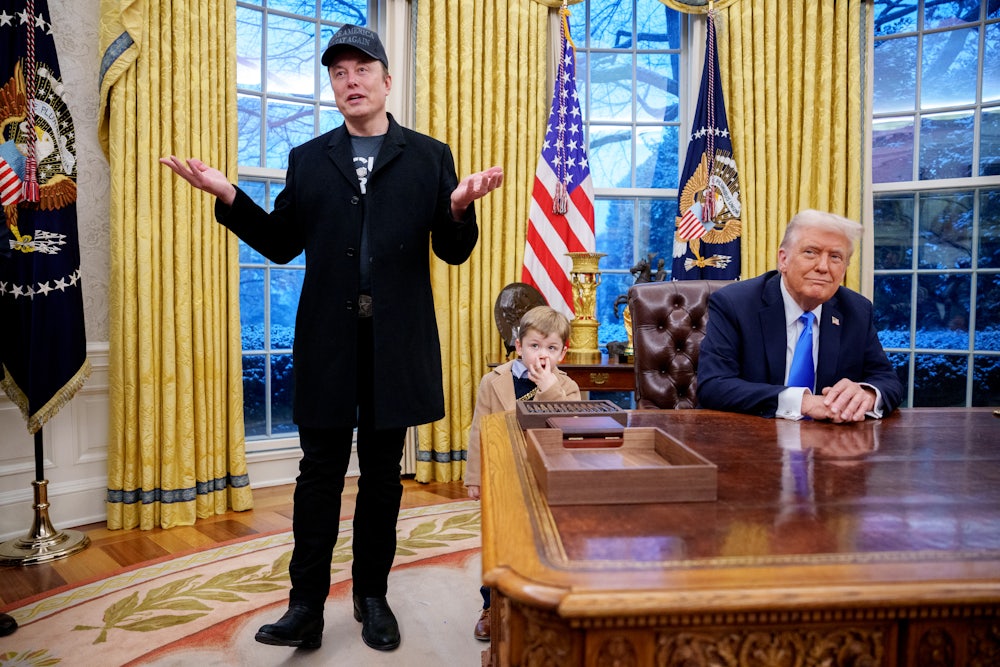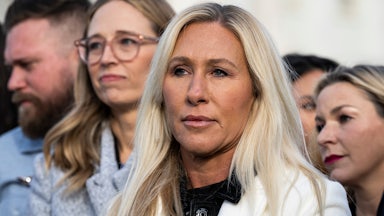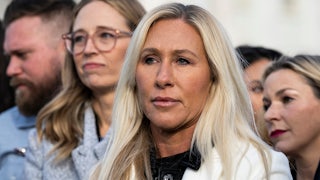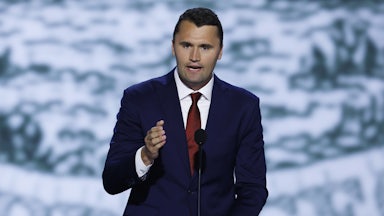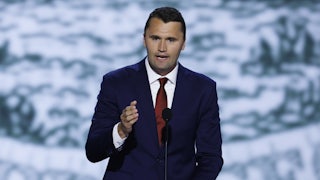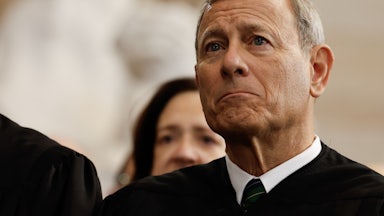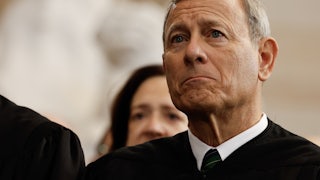Wednesday is Liberation Day, and one person might be even more excited about it than Donald Trump is: Elon Musk. While much of what the president will announce from the Rose Garden on April 2 remains a mystery, Trump has already declared that 25 percent tariffs will kick in this week on imported cars and light trucks—to be followed by tariffs on auto parts as well. Economists, car dealers, and consumers are sounding the alarm, and rightly so. “If the taxes are fully passed onto consumers,” the AP reports, “the average auto price on an imported vehicle could jump by $12,500.” But Trump said he “couldn’t care less” if that happens because then “people are gonna buy American-made cars. We have plenty.”
Well, not really. There is no such thing as a truly American-made car, if you take into account the origin of the parts. And even “American” brands, like General Motors and Ford, assemble a significant amount of their vehicles abroad. But when looking for the most American-made vehicles, one manufacturer stands out: Tesla. Its fleet is 100 percent assembled in the United States.
This is just the latest of many examples—almost too many to count—of Trump’s policies redounding directly to Musk’s benefit. From executive orders to foreign misadventures, much of what crosses Trump’s desk or flits through his birdbrain is in Musk’s material interest. Even Trump’s own political interests are taking a back seat to enriching Musk, who donated nearly $300 million last year to help Trump and his MAGA minions get elected. The generous (albeit still damning) interpretation is that the president is merely returning that favor; less favorably, he’s in Musk’s back pocket. Either way, the great con man Trump has met his match—now he’s the one being conned.
The Tesla CEO claimed last week that his company will also be significantly impacted by the tariffs because it imports some of its auto parts. But because Tesla’s vehicles are made in California and Texas, and it imports fewer parts by value than other manufacturers, it will have a tremendous competitive advantage.
And even if the tariffs do ding Tesla, well, Musk can take heart that he’s making off like a bandit in so many other respects under the Trump administration.
Last week, Trump sent JD Vance to Greenland, where the vice president said the territory’s mother country, Denmark, had “underinvested” in the island’s people and its “beautiful landmass.” It’s the latter that so intrigues Musk and others in Silicon Valley, since the resources there—an abundance of rare earth elements needed for lithium-ion batteries, on which Teslas run—could represent a major windfall for the tech industry. No wonder Musk tweeted earlier this year, “If the people of Greenland want to be part of America, which I hope they do, they would be most welcome!”
Of course, Trump’s obsession with critical minerals has also played a major role in the batshit negotiations over ending Russia’s war on Ukraine. The president twice mentioned the embattled country’s “rare earth” when he proposed a “deal” to end the war that was really more of an extortion attempt—asking Ukraine to pay the U.S. $500 billion in minerals in exchange for continued American aid. This eventually led to Trump and Vance’s embarrassing Oval Office ambush of Volodymyr Zelenskiy, for which Musk had helped set the stage by laying accusations against the Ukrainian president and repeatedly suggesting he be removed.
Other proposals have Musk’s fingerprints all over them as well. As Paul Waldman pointed out for TNR, a Biden-era program to improve broadband access and service in areas of the country that lack high-speed internet is now being revised in a way that will allow Musk’s satellite internet provider, Starlink, to underbid competitors and secure $20 billion in government funding—while also providing service that is inferior to the fiber connections that the program favored. Unsurprisingly, the advantages that Musk will receive have been presented as a win for the American people. The former head of the program hit the nail on the head: “Stranding all or part of rural America with worse internet so that we can make the world’s richest man even richer is yet another in a long line of betrayals by Washington.”
In fact, Starlink keeps showing up these days. What explains Musk’s animosity toward USAID, which his Department of Government Efficiency has been busy dismantling? Perhaps it stems from the agency’s investigation of its contract with the company to provide Ukraine with internet access. Starlink has also been installed throughout the White House campus and at the DOGE-allied General Services Administration.
Nothing Musk does runs contrary to his own ambition. Starlink is a wholly owned subsidiary of SpaceX, which Musk founded. He didn’t appreciate the Federal Aviation Administration’s probe of his company, so he launched an online campaign pressuring its head, Michael Whitaker, to resign and then axed many others at the agency—exacerbating a staffing crisis that has coincided with several deadly collisions. Not to worry: The FAA is going to be using Starlink for its soon-to-be upgraded technology networks. You can be sure the competition for the contract was fierce.
Must be a coincidence, too, that SpaceX engineer Theodore Malaska happens to be just the right person to serve at the FAA, where he’s been granted an ethics waiver to oversee projects that directly impact the company he works for. Ordinarily such a situation might raise ethics concerns, given the clear conflict of interest and lack of governmental impartiality, but it’s alright because we all know Musk wouldn’t engage in anything unethical, right? Otherwise we might also be suspicious of the fact that, while DOGE is going around infiltrating and cutting agencies, it’s essentially suggested no spending cuts to NASA or the Pentagon, both of which have massively increased their investments in SpaceX.
That wasn’t the case with the National Highway Traffic Safety Administration, which has seen a 10 percent workforce reduction, possibly impeding the six investigations it was conducting into Tesla’s self-driving technology.
But we can trust Musk to oversee himself, we’re told. Just last week, he negotiated with himself so that his xAI company could purchase his X social media platform, claiming respective valuations of $80 billion and $33 billion—both undoubtedly inflated figures. In fairness, all that really matters in such an arrangement is the stock ratio for investors, but Reuters did note that it was “unclear … whether there would be regulatory scrutiny.” Such scrutiny would come from the Securities and Exchange Commission, which Musk’s DOGE team has invaded.
Similarly, Trump is attempting to eliminate the Consumer Financial Protection Bureau, which, if successful, would eliminate the government agency that had planned to regulate Musk’s proposed mobile payments service on X. Yet Musk’s ambitions go well beyond digital payments. Combining xAI with X and its Grok service will position him well to embark on an even bolder agenda that will leave the federal government more dependent on him and his companies than ever: Musk has instituted an AI takeover of government data, potentially making him and xAI indispensable to future government operations.
Even before Musk fully sinks his AI claws into our government, it’s hard to overstate the leverage Musk now has. Through his effective control of both the General Services Administration and the Office of Personnel Management, Musk oversees hirings and firings, data systems, federal buildings, and government vehicles. Perhaps that explains why the State Department is expected to spend around $400 million to purchase Teslas to transport diplomats. The question is whether any foreign representatives will want to be seen being shepherded around town in a vehicle that has become synonymous with cruelty and douchebaggery.
In fact, the one thing Musk didn’t seem to plan on when he spun his big con of Trump was the blowback he’d receive. The resistance, declared dead by many as Trump took office for his second term, has shown signs of life of late, as growing anti-Musk sentiment has been directed in part at Teslas—including large protests at its dealerships across the country. I guess that recent Tesla infomercial on the White House lawn, yet another example of Trump doing Musk a solid, has backfired.
The key to pulling off a big con, Henry Gondorff tells Johnny Hooker in 1973’s The Sting, is maintaining the façade: “He can’t know you took him.” Right now, that’s exactly what Musk is doing with Trump. For the low price of $288 million—chump change when you’re the world’s richest person, valued at $350 billion—Musk has been handed the keys to the U.S. government and given the run of the place, while Trump seems to have convinced himself that he’s still in charge. Meanwhile, angry crowds are storming Republican town halls, furious that DOGE is killing jobs, destroying vital services, and attacking the social safety net while enriching Musk. Elections are turning in Democrats’ favor, potentially imperiling Trump’s power to enact his agenda. And yet, there sits the duped president behind the Resolute Desk, grinning like a senile old lady who’s happily given out her bank card and Social Security number to a cunning younger man with an accent.
